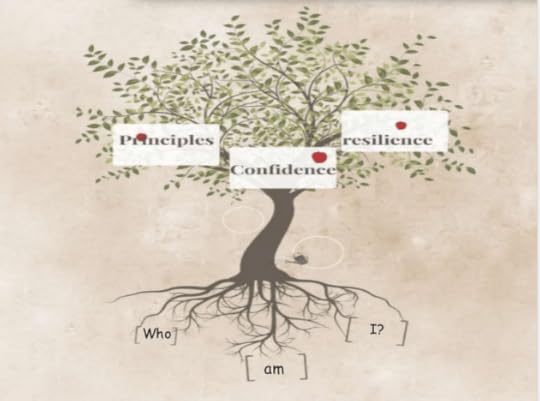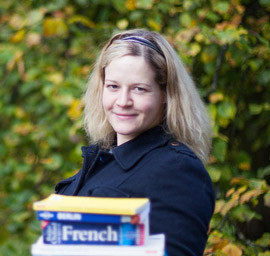André Klein's Blog, page 12
September 21, 2015
Kirsty: “It’s important for trainers and course providers to gain credibility by building an online presence”
The following interview is part of an interview series in which we feature education professionals from a variety of different fields in order to highlight individual efforts and creative solutions to education in the 21st century. If you want to participate simply write down and send your answers to the five below questions to info {at} learnoutlive.com and include a picture of yourself. (Please note that we reserve the right to not publish all submissions)
1. Who are you and what do you do in education?I’m Kirsty Major from English with Kirsty. I work with adults who want to develop their business English skills and to feel confident about using English in the workplace. I work predominantly with people in Germany and Switzerland as I also speak German.
2. Describe a typical work day in your life!No two days are the same and this is what I love about my job!
I use different platforms, but all of my training is provided online. This is good for me, because I don’t have to spend hours travelling around from student to student, and it’s good for the students too because they can save time and money in the same way.
 As English has become important in so many fields of work, I work with a range of professionals from different fields. There are many similarities in terms of the areas that my learners want to cover. For example, we work on improving their speaking skills for meetings, giving presentations or using the telephone. I also assist them to develop their writing skills so that they can communicate confidently and effectively by email or when they need to produce documents and presentations. However the subject material for those meetings or telephone calls is vastly different and this brings exciting variety to my work.
As English has become important in so many fields of work, I work with a range of professionals from different fields. There are many similarities in terms of the areas that my learners want to cover. For example, we work on improving their speaking skills for meetings, giving presentations or using the telephone. I also assist them to develop their writing skills so that they can communicate confidently and effectively by email or when they need to produce documents and presentations. However the subject material for those meetings or telephone calls is vastly different and this brings exciting variety to my work.
Each day, I could be teaching any of a number of programmes which include one-to-one conversation courses, a business English course or a grammar course. I also have self-study programmes and an trainer-supported writing course.
As well as teaching, I also spend time working on audio content for my podcast and articles for my blog so that I can grow my online network and bring my products before new audiences.
3. In what way has technology in general and the net in particular changed your work?I wouldn’t say that these things have changed my work as I didn’t work in this field prior to all the advantages of modern technology being available. However, as all of my training takes place online, I would not be able to work in the same way if I did not have access to the internet. I would also have great difficulty in communicating with potential customers as I don’t focus on a local market.
Using the internet means that it’s no longer necessary for me to be in the same city or even the same country as my learners. This is also an advantage for learners because it means they are not restricted to the trainers in their immediate vicinity. They can spread the net wider and consider training programmes from a much wider group of training providers.
4. What challenges do you see for education in the future?The point that I have just named as an advantage in question three can also be a challenge. There is so much information available online now that it can be overwhelming for customers when they begin to search for relevant and useful training. This is why I believe it’s important for trainers and course providers to gain credibility by building an online presence and demonstrating that they can provide quality content that potential customers can sample before signing up for training.
In addition, whilst I don’t think that learners now have a shorter attention span, I believe they are quicker to disregard material if they don’t believe it to be easily accessible or relevant. Therefore we need to develop or use training materials that are engaging and that meet the learners’ needs.
5. Where can we find you online?You can visit my website:
www.englishwithkirsty.com
join in the conversation on my Facebook page:
www.englishwithkirsty.com/facebook
or listen to my podcast – either on iTunes or on my website:
www.englishwithkirsty.com/podcast

 About the author:
LearnOutLive Interviews is an interview series in which we feature private teachers and education professionals from a variety of different fields in order to highlight individual efforts and creative solutions to education in the 21st century. If you want to participate simply write down and send your answers to these five questions to info {at} learnoutlive.com and include a picture of yourself. (Please note that we reserve the right to not publish all submissions)
About the author:
LearnOutLive Interviews is an interview series in which we feature private teachers and education professionals from a variety of different fields in order to highlight individual efforts and creative solutions to education in the 21st century. If you want to participate simply write down and send your answers to these five questions to info {at} learnoutlive.com and include a picture of yourself. (Please note that we reserve the right to not publish all submissions)
The post Kirsty: “It’s important for trainers and course providers to gain credibility by building an online presence” appeared first on LearnOutLive.





September 16, 2015
How to Create Your Own Mission Statement as an Online Teacher

If you are already reading this article or felt a tingle of recognition or awareness upon spotting the blog title, then you already know that teaching is not a job, it’s a mission. You’ll be doing it every day for the rest of your life, so it IS your life. When you are asking yourself how you want to teach, who you want to be as a teacher, and when you are digging a little more deeply into your own needs and wishes, you are really asking yourself how you want to live your life. By choosing to teach, you are choosing to give, regardless of what you will give or who you will give it to. In fact, we could argue that you are not living if you’re not giving.
As teachers we are very profound creatures indeed. The knowledge we share can be either blessed or cursed by the spirit in which we share it. Objective facts are like trees falling in the forest that no one can hear. The falling tree should have cause – effect and sound, but there is no human engagement or sense of action, so its significance and reality is lost.
As teachers we must be significant and real in a subjective sense in order to engage the human spirit. We want our students to hear us – really hear us. As individuals we cannot be real if all we do is merely adopt hand-me-down principles and ill-fitting beliefs. As teachers we cannot have a significant impact on others if we cannot define, plan and map out our own visions of life and learning.
Although I believe that mission statements are important in all walks of life, I’ll be referring specifically to online teachers in this article. Things like ”reality”, ”tangibility” and ”social proof” take on an extended significance for online teachers as they are literally being ‘born again‘ in virtual worlds.
You are the mission

I believe that we subconsciously share our mission statements on a daily basis. A chosen word, smile, a favourite quote, song, or book – all of those things define us in any given moment. These fragmented thoughts, dreams, feelings and inspiration are just ephemeral clouds, however, if we don’t capture them in a lifelong vision. While we should never stop dreaming, cloud-watching or changing our dreams, there should be a fundamental purpose, a bigger picture within which your dreams, moments, and thoughts will feel free to dare greatly.
Fear of the unknownLack of vision feeds fear. Fear thrives on insecurity. Insecurity hurts ourselves and our students. Your teaching values, talents and vision help you to know the unknowable. This is the confidence that drives away fear and inspires others to do great things.
Five ways to map your mission.

How are you going to keep physically and mentally fit it ways that will support your work? How are you going to keep inspired and keep learning? What is it all going to mean in the future when you look back on your life?
Mission statements are not about to-do lists or short term goals, or even long term goals. They are expressions of your lifelong purpose. When you plan for work, plan for the other parts of your life, as they will enhance your working life in the long run.
2) Take time out for yourselfGo somewhere quiet in nature, such as a beach, a forest, or a garden. Then follow these instructions.
a) Sit somewhere, try not to think and listen to the sounds around you till you feel relaxed bough to listen to yourself.
b) Try reaching back by remembering things you loved from your childhood or meaningful memories.
c) Re-examine your motives by thinking deeply about why you do what you do and why you make certain decisions.
It should become clear upon deep reflection what motivates you, and which lifelong values underpin these motivations. When your values and principles take on new meaning for you, you will make better decisions on your career and teaching life, as your mission will be clear.
d) Write your troubles in the sand as scribbling down problems and watching the tide wash them away is a symbolic act. If you’re not near a beach you can still write your problems somewhere on paper and think of a symbolic way of getting rid of them, such as tearing up or burning the paper. Humans are creatures of ritual and drama – your missions demands it;)
You are now tough enough to live out your newly defined purpose for work and life.
3) Draw or design your mission on a mindmapMindmapping helps you to build up a creative flow through making subconscious associations on paper or on a mindmapping application. The key words and images you come up with can tell you a lot about who you really are deep down and how this will play our in your professional life.
Here’s an article about mindmapping if it is a new concept for you.
4) Journal your thoughtsSee how the story of your heart and mind reveals itself to you. One way of doing this is to ask yourself some key questions and then start writing, scribbling or doodling without thinking about your words. When you read it back, how does it make you feel? Inspired, surprised, scared? Hopefully all of those and more.
5) Take a shortcutIf you feel stuck or feel that you’re never going to write it, one short-cut is to gather up a kind of scrapbook of your daily mini-inspirations. Think of a song, a book, a quote, an experience, a laugh, moment. What is so special about all of these little things? What is the common denominator? Is it the people, the synergy, is it the beauty of language, ideas? What could you do with these ideas and experiences in your work and life? Try experimenting with little inspirations, integrate them into your work and blog about them.
Five ways to publish your mission statementAs online teachers we can’t get creative without publishing. Also our mission statements, in this case, are professional statements, so they can be showcased on our websites, resumes and social media profiles if we so wish.
1) You can blog your statement and put it on a video or other multi-media style presentation and share it with your personal learning networks.
2) You can mindmap or sketchnote, or doodle it as I said before. Combining word with imagery makes the statement all the more powerful.
Here’s an article about visual design which explains this power.
3) Make an infographic of your mission statement.
4) Keep a teaching blog diary that describes your daily or weekly goals and achievements. Always make sure they are in line with your vision and make changes where necessary as you go about your teaching life.
5) Write a letter to your future self about your mission, goals and dreams. Put the letter in a bottle and bury it for 365 days or give it to a friend for safe keeping. Go back in a year and see what changes you’ve made towards becoming the teacher you want to be.
Publish your successes, blog about them, write an ebook, create new courses, hold webinars, help others to do what you did.
Finally, crafting the mission statement can be simpleA paragraph that incorporates mind, body, and spirit principles should cover the values you need for a rich career and life. Revealing your mission statement to yourself is really a work of detection. Your purpose is within you and you need to make it part of your persona, brand, personhood and professional identity.
Revealing your mission statement to the world will make you stand out, become a confident teacher and brand your work with integrity, clarity and insight.
People will know where to find you and you will know where to find yourself. Virtual reality, social media and online networks will not drown out your true presence, they will amplify it.
You will know exactly how you want to help people and they will respond to your message.
–
References:
Listen to yourself:
Ideas for this paragraph adopted from Covey S; 2013, How To Develop Your Personal Mission Statement,Grand Harbour Press
“Daring Greatly” inspired & coined by Browne B; 2013, Daring Greatly: How the courage to be vulnerable transforms he way we live, love, parent and lead, Portfolio Press.
–

You’ve been reading a guest post by Sylvia Guinan
Sylvia Guinan is an online English teacher, writer and blogger who facilitates professional development online.She uses brain-friendly techniques to help students and teachers around the world She blogs and runs courses on the WiziQ platform and runs her own website. She is also Joint Web Editor for the IATEFL Learning Technologies Special Interest Group.
.acirc{float:left;margin-right:12px;box-shadow:0px 1px 5px #E4E4E4;border-radius:50px;border:1px
solid #DBDBDB;height:100px;width:100px;overflow:hidden}
The post How to Create Your Own Mission Statement as an Online Teacher appeared first on LearnOutLive.





September 2, 2015
How Well Do You Know German Culture? Test Your Knowledge With This Quiz!
Hello, German learners and Germanophiles! Do you have what it takes to nail all the answers to our little German culture quiz? Here are 10 questions from the world of German food, drinks and the esoteric arts of “Mülltrennung” (recycling).
Ready? Let’s go, or as we say in Germany: “Los geht’s!”
1. How much beer is in a German “Maß” glass?

photo by Skley via Flickr (CC)
0.5 liters
0.75 liters
1 liter
2. What’s this creature found in many German gardens?

photo by Astra Nilsson via Flickr (CC)
ein Gartenzweig
ein Gürtelzwerg
ein Gartenzwerg
3. How do you call this local delicay?

photo by WordRidden via Flickr (CC)
Bratwurst
Currywurst
Fleischwurst

photo by Nico Kaiser via Flickr (CC)
in October, of course!
early November
mid-September

photo by Urban Explorer Hamburg via Flickr (CC)
apple juice with vodka
apple juice with soda water
apple juice with ice
“auf Kipp”
“auf Halb”
“auf Winkel”

photo by matsuyuki via Flickr (CC)
“Hallo, Riesen Bonbons!”
“Halb ribbelfeste Botanik”
“Hans Riegel Bonn”

photo by roitberg via Flickr (CC)
Germans hated the taste of Coca-Cola.
production of Coca-Cola was difficult.
nobody wanted a brown soft-drink.

photo by RvMWillich via Flickr (CC)
blue for organic, brown for paper, yellow for plastic waste
blue for plastic, brown for organic, yellow for paper waste
blue for paper, brown for organic, yellow for plastic waste
10. These are not “french fries” or “chips. We call them …

photo by manoftaste.de via Flickr (CC)
Fritzies
Fritzen
Fritten

 About the author:
André Klein was born in Germany, has grown up and lived in many different places including Thailand, Sweden and Israel. He has produced two music albums, performed and organized literary readings, curated an experimental television program and is the author of various short stories and non-fiction works.
About the author:
André Klein was born in Germany, has grown up and lived in many different places including Thailand, Sweden and Israel. He has produced two music albums, performed and organized literary readings, curated an experimental television program and is the author of various short stories and non-fiction works.
The post How Well Do You Know German Culture? Test Your Knowledge With This Quiz! appeared first on LearnOutLive.





August 25, 2015
Tips and Tools for ESL Students: How to Master the Art of Essay Writing

Casual English language learners are not much interested in academic writing. They only need to master conversational tone, so advanced written forms are way out of their league. However, if you are a serious learner, who wants to use English in business communication, then essay writing skills are absolutely necessary for you.
ESL students often don’t see the point in learning how to compose lengthy papers, since the careers they are after are not based on such skills. However, the practice of academic writing is important because it teaches you how to express yourself with authoritative, believable arguments. That skill will boost your success on any career path!
Now that we made the importance of essay writing clear, let’s see how you can master this artistry. In the continuation of this article, you’ll discover the most useful strategies and tools that will make essay writing more attractive and easier for you.
Essay Writing Tips for ESL Students1. Pay a lot of attention to the thesis statementWithout a clear thesis statement, your paper will be a disorganized, pointless piece of paper. This statement should identify the purpose of your essay, so the reader will immediately know what he is about to read. You cannot just contemplate for few minutes and come up with an awesome statement; this part of the project requires planning!
Two of the strategies you can rely on are brainstorming and mind mapping. For brainstorming, you use a piece of paper or an online/smartphone tool to write down everything that comes to your mind. Think about the broad topic and write all ideas you have. Then, you’ll distinguish the best one and use it to proceed with mind mapping.
The mind map is a diagram that shows the connection between different concepts. Think about the idea you chose and write all arguments that you can use to support it. Link the arguments between each other and make sure all of them are directly related to the main idea. This mind map will help you form a thesis statement that grasps the essence of your paper.
2. Write in clear toneAs an ESL student, you may fall into a trap thinking that more complex words would make you seem smarter. When your teachers are evaluating your vocabulary, they are not looking for long words that require a dictionary; they want to see how you can express even the most complex arguments through ideas that everyone can understand.
3. Analyze perfect samplesIf you want to understand this genre, you should read some of the greatest essays ever written. Although the style of authors like Jo Ann Beard and Annie Dillard may be too complex to understand when English is not your native language, their work will at least inspire you to explore essay writing on a deeper level.
Essay Writing is Not Scary When You Rely on the Right Tools!1. The Purdue Online Writing Lab offers explanations for different types of essays, citation standards, and all details on academic writing you could possibly need. The section for ESL instructors and students covers the basic concepts of writing. That’s exactly where you should start!
2. Write My Essay will help you complete the most challenging essays. This essay writing service connects you with professional authors who are educated in the topics you are struggling with. Plus, they are trained in essay writing, so you’ll learn how to craft a paper from scratch when you monitor their work.
3. Evernote is one of the best productivity apps out there. You can use it to collect online resources for your essays, take notes or write sections of your paper whenever you get ideas, and connect with people who can provide feedback on your work.
4. Cite This For Me makes referencing less stressful than ever. You must be aware of the dangers of plagiarism; copying practices never lead to successful results. This browser extension will give you correct references of online sources, so you won’t waste time thinking about citation standards.
5. FocusWriter is a distraction-free writing environment that will help you achieve ultimate levels of productivity. The interface is hidden, so you’ll have access to a full screen that’s waiting for your words.
6. Bubbl.us is an online tool that combines brainstorming and mind mapping into one process. It enables you to create a compelling presentation of your ideas. The map will keep you focused through the writing process.
Are You Ready to Start Exploring the Art of Essay Writing?Academic writing can never be easy, especially when English is your second language and you have to discover new terms that make your arguments more believable. However, essays are a necessary aspect of every learner’s journey. You can start writing masterful papers if you learn how to write a strong thesis statement, you simplify the writing tone, and you analyze the pieces of some of the most famous essayists of our time. The Purdue Online Writing Lab, Evernote, Ninja Essays, Cite This For Me, FocusWriter, and Bubble.us are the tools that will support you on that mission.
Now that you know how to approach the writing process, it’s time to practice! Start implementing these tips and tools into your writing routine and you’ll immediately notice the difference!
–

You’ve been reading a guest post by Robert Morris
Robert Morris is an educator, tutor and writer from NYC. He writes guidelines for college students, and works as a scholarship assistant. Follow Robert on Google+!
.acirc{float:left;margin-right:12px;box-shadow:0px 1px 5px #E4E4E4;border-radius:50px;border:1px
solid #DBDBDB;height:100px;width:100px;overflow:hidden}
The post Tips and Tools for ESL Students: How to Master the Art of Essay Writing appeared first on LearnOutLive.





August 3, 2015
Creativity And New Technologies In The Foreign Language Classroom: A Practical Case

img via flickr by opensource.com
“Education is the kindling of a flame, not the filling of a vessel” – Socrates
In his book Out of Our Minds: Learning to be Creative Sir Ken Robinson defines creativity as “the process of developing original ideas that have value.” In his opinion, to be creative means to play with ideas. Enjoyment and the use of our imagination are necessary elements of creativity. That sounds great, doesn’t it? Now you must be thinking: I would like to be creative!
Perhaps you do not see yourself as a creative person, or have not personally met many creative people in your life and therefore you might be suspicious of the definition above. Well, you are right to be suspicious because there are certain conditions that need to be fulfilled if we want to kindle our creativity. For Ken Robinson, one of them is “a love for particular materials or instruments”. Another condition would be “working in a highly focused way on ideas and projects, crafting them into their best forms”. And he also points out that “creativity also draws on skill, knowledge and control”. Maybe at this point some of you might be starting to feel skeptical about the possibility of doing something creative. Keep reading if you are asking yourself this question: Can I be creative at all?
We all know about the huge creative capacities that children have. Somehow, most of us lose them as we grow up. Can we as adults be creative persons again? Yes, we can, but creativity is not going to happen overnight because it is a process. The author believes that “we are all born with immense natural talent but too few people discover what they are and even fewer develop them properly.” Why is that so? Ken Robinson give us a very clear and disturbing answer: it is the educational system’s fault. Ironically enough, education is to blame. A lot of talent is going to waste because our educational systems are obsessed with certain types of academic ability and standardized testing.

img via flickr by opensource.com
Parents and teachers need to be aware that “creativity is possible in every discipline and should be promoted through the whole of education”. Sadly, traditional methods of teaching and standardized testing have stifled creativity in the classroom for too long. However, nowadays more and more teachers are willingly taking the role of guides and facilitators because it allows them to engage with their teaching and with their students more effectively. It is time for a change, and the new technologies can help us if we learn how to use them properly. In many parts of the world, teachers have access to the new technologies and use them out of the classroom in their daily lives. They should be encouraged to use their laptops, tablets and smart phones in the classroom too because they can help our students to be creative in new ways.
There is one teacher who believes that creativity can be promoted in the foreign language classroom. In his inspiring article My best languages lesson: putting Spanish into practice with online books, José Picardo explains how he gets his Spanish class to write and produce their own virtual stories using a web-based tool called Storybird. This tool offer students (and educators) many possibilities to develop their creativity. Students can create art-inspired picture books, serialized long form stories, and poetry.
They can write and publish their own books in a safe environment. It can be used to consolidate pre-existing knowledge, to work on a grammar point, to expand vocabulary, etc. The wide choice of illustrations available help to spark creativity. The result of the process is a tangible outcome that have value (e-book) and that can be reviewed by the teacher and the other students. And more importantly, students enjoy using this tool because they love the instrument (laptop or PC) and enjoy applying their knowledge and imagination.
This is a great example of how the use of the new technologies can help students to get involved in their process of learning and be more creative. I cannot wait to use it with my students and see their creativity unfold!
–
You’ve been reading a guest post by Alberto Castilla

“My name is Alberto Castilla. I began teaching languages six years ago and I do not believe teaching is a vocation. I believe it is vocational, as in something you can train people to do. I am a teacher because I enjoy helping others learn and think autonomously. I have lived in different countries and learned English, Italian and Chinese. I teach Spanish online at ayaespanol.com and English offline. I am interested in education and language learning.”

 About the author:
Alberto Castilla says: “I began teaching languages six years ago and I do not believe teaching is a vocation. I believe it is vocational, as in something you can train people to do. I am a teacher because I enjoy helping others learn and think autonomously. I have lived in different countries and learned English, Italian and Chinese. I teach Spanish online at ayaespanol.com and English offline. I am interested in education and language learning.”
About the author:
Alberto Castilla says: “I began teaching languages six years ago and I do not believe teaching is a vocation. I believe it is vocational, as in something you can train people to do. I am a teacher because I enjoy helping others learn and think autonomously. I have lived in different countries and learned English, Italian and Chinese. I teach Spanish online at ayaespanol.com and English offline. I am interested in education and language learning.”
The post Creativity And New Technologies In The Foreign Language Classroom: A Practical Case appeared first on LearnOutLive.





July 29, 2015
A FREE Fantasy Adventure For German Learners In Your Web-Browser

If you’ve been following out Twitter or Facebook updates, perhaps you’ve heard that the third and final part of the Aschkalon fantasy adventure for German learners is now finally available as paperback edition. Yay!
Now that all three parts are available as electronic and paper editions, I wondered what to do next. First of all, since some people wished the single episodes were a bit longer I created a complete edition which contains all the episodes in one big book.
From Kindle Edition To the Open WebAnd then I thought … wait a second! Now the whole trilogy exists in one book and since it’s written in very basic HTML code which runs in every browser, why not liberate the story from paper pages and Kindle screens and bring it to web-browser worldwide, free of charge?
So, without further ado I present to you the Complete Web Edition of Aschkalon, the interactive fantasy adventure for German learners, free to enjoy on any web-browser. Here’s a preview:
As you can see in the video, you get a small dictionary at the end of each scene to help with difficult words, but if you need more help, feel free to use the excellent Lingua.ly browser extension to get translation and pronunciation for single words and add the vocabulary to a flashcard stack for further study.
The whole project is in beta stage at the moment, so any feedback is greatly appreciated. Also, if you find any bugs, broken links, etc. please add a comment under this blog post or contact me directly and I’ll continuously improve this (as time allows).
In case you missed it, here’s the link again: learnoutlive.com/aschkalon – Read, play, learn, share it with your friends!
–

 About the author:
André Klein was born in Germany, has grown up and lived in many different places including Thailand, Sweden and Israel. He has produced two music albums, performed and organized literary readings, curated an experimental television program and is the author of various short stories and non-fiction works.
About the author:
André Klein was born in Germany, has grown up and lived in many different places including Thailand, Sweden and Israel. He has produced two music albums, performed and organized literary readings, curated an experimental television program and is the author of various short stories and non-fiction works.
The post A FREE Fantasy Adventure For German Learners In Your Web-Browser appeared first on LearnOutLive.





July 16, 2015
Laura: “It’s essential for schools and teachers to offer something unique”
The following interview is part of an interview series in which we feature education professionals from a variety of different fields in order to highlight individual efforts and creative solutions to education in the 21st century. If you want to participate simply write down and send your answers to the five below questions to info {at} learnoutlive.com and include a picture of yourself. (Please note that we reserve the right to not publish all submissions)
1. Who are you and what do you do in education? I’m Laura K. Lawless, American by birth and permanent ex-pat by choice: after living in Morocco, Costa Rica, and France, I finally settled in Guadeloupe, where my husband and I are building a house and three vacation rentals. I have a BA in International Studies from Monterey Institute and did some graduate work in translation and interpretation but never finished my MA.
I’m Laura K. Lawless, American by birth and permanent ex-pat by choice: after living in Morocco, Costa Rica, and France, I finally settled in Guadeloupe, where my husband and I are building a house and three vacation rentals. I have a BA in International Studies from Monterey Institute and did some graduate work in translation and interpretation but never finished my MA.
I’ve always been fascinated by language. I speak fluent French and conversational Spanish, as well as a few phrases of Italian, Moroccan Arabic, and Greek.
I’ve been a virtual teacher since 1999, when I started teaching French on a free (ad-supported) website. I write lessons, create listening and reading comprehension exercises, put together vocabulary lists with sound files, share learning and teaching tips, and answer readers’ questions via forum and social media.
For several years, I also worked on Spanish and English sites, but they are pretty much inactive at this point; all my time now goes into French.
2. Describe a typical work day in your life!I wake up at 6 am and, even though I know it’s not the most productive way to begin the work day, I always start with a communications check: email, social media, and forum. Once I’ve answered questions and dealt with any technical issues, I dive into writing new lessons, updating old ones, translating texts, making sound files, and searching for public domain photos to illustrate vocabulary lessons and expression explanations.
I typically work for about an hour, then do another communications check, then write some more. I publish a new feature on my site every day, and share it on social media. I keep a list of upcoming features in my html editor, and always have at least half a dozen in various states of completion. If I get bored with a particular lesson or feel uninspired, I immediately move on to another, as I’ve found that is the best way to maintain my productivity. When I need a break, I go swimming, do something creatively delicious in the kitchen, or play online games. These enjoyable but more or less mindless activities leave my brain free to puzzle over tricky concepts and figure out the best way to word a particular idea.
My newsletter is sent twice a week with the previous few days’ features. I work 6-8 hours a day, 7 days a week, but I tend to check email several times even after I’ve officially quit work (i.e., walked away from my computer) for the day.
3. In what way has technology in general and the net in particular changed your work?In pretty much every way there is. I never had any intention of being a teacher, but I didn’t manage to become an interpreter, and didn’t like working in an office, which is what I had to do for years once I left school.
When I got desperate to do something language related, I taught adult ed for a year, but I decided not to continue – I just don’t have a knack for teaching people face to face. Then the opportunity to teach French online came along, which sounded like an interesting challenge, and it turned out that I am very good at teaching from a distance. Without the internet, I guess I’d be working on more books – I’ve written several, including Intermediate French for Dummies.
4. What challenges do you see for education in the future?With so much information freely available online, it’s harder and harder for people to justify paying for education. Even though logic tells us that online learning can’t possibly be sufficient to really master a topic or skill, it can be appealing to stick to free tools like the internet, rather than investing money and effort into finding and attending classes, or traveling to the country where the language you’re learning is spoken.
It’s essential for schools and teachers to offer something unique, something that sets them apart from the rest. But it’s especially tricky for online content creators: there’s a lot of competition, and unless you can hire a team to handle the technical and social aspects, you have to do much more than just write great content. Ten years ago, 95% of my time was spent writing; now, it’s more like 50%.
Unfortunately, there’s also a lot of poorly written content and even misinformation out there, so it’s up to each learner to seek out high-quality websites, which aren’t necessarily the largest or the ones that live at the top of search engines.
5. Where can we find you online?

 About the author:
LearnOutLive Interviews is an interview series in which we feature private teachers and education professionals from a variety of different fields in order to highlight individual efforts and creative solutions to education in the 21st century. If you want to participate simply write down and send your answers to these five questions to info {at} learnoutlive.com and include a picture of yourself. (Please note that we reserve the right to not publish all submissions)
About the author:
LearnOutLive Interviews is an interview series in which we feature private teachers and education professionals from a variety of different fields in order to highlight individual efforts and creative solutions to education in the 21st century. If you want to participate simply write down and send your answers to these five questions to info {at} learnoutlive.com and include a picture of yourself. (Please note that we reserve the right to not publish all submissions)
The post Laura: “It’s essential for schools and teachers to offer something unique” appeared first on LearnOutLive.





July 13, 2015
3 Quick Ways To Get Into German Dialects

photo by Marc Wathieu via Flickr (CC)
German is a language spoken by over 100 million people in the world, but did you know that Hochdeutsch is only one out of hundreds of dialects? Our country might be small, but its fractured history has led to the development of many varied regional identities and dialects. The German you are learning in Duolingo, online classes and textbooks is our standard dialect and will help you understand the language anywhere.
But if you want to add some local flavours and discover more of the country, here are three ways of expanding your local knowledge.
1. Deutscher DialektatlasDeutsche Welle have put together a fabulous guide to the German regions and dialects. It introduces the country and its people with beautiful images and audio images of each dialect at its strongest. For me as a Mosel girl, the inclusion of Moselfränkisch was a matter of pride. The region is very small, but down to each village we celebrate our local identities.
2. Die dritten ProgrammeThe third TV channels in Germany focus on supporting regional TV productions, news and other reports. There are nine of them in total, meaning they obviously cover regions that contain several dialect areas, but it is easy to find the right region for your studies. Look for local reports from events or anything in the programme that tells you where the report was filmed.
Watching regional TV is particularly useful because you will get to know the country a little bit better, learning about what grows on local fields and which industries people work in. It’s any German learner’s dream and easily accessible through the ARD Mediathek.
You can select your favourite channel from the dropdown list here:
Here’s what they all mean:
Bayerisches FS (sometimes known as “Bayern 3”): the Bavarian channel (including Munich)HR-Fernsehen (sometimes known as “HR”): the Hessen channel (including Frankfurt)MDR Fernsehen: the “new Bundesländer” of Eastern Germany (including Saxony)NDR Fernsehen: the Northern German channel (including Hamburg)Radio Bremen: radio from the trade city of Bremen in Northern GermanyRBB Fernsehen: TV channel covering our capital Berlin and BrandenburgSR Fernsehen: TV channel for the Saarland regionSWR Fernsehen: the two South West German channels for the states of Rheinland-Pfalz (RP, including Mainz) and Baden-Württemberg (BW, including Stuttgart)WDR Fernsehen: the “West German Broadcast” channel, which means it covers Rhine and North Rhine Westphalia (the “German Midwest”, including media capital Cologne)3. TatortIt’s impossible to talk about German media without mentioning Tatort, the country’s longest-running Sunday evening tradition. Tatort has been running on the ARD channel since 1970 and famously neither its theme tune nor its title sequence have changed. The crime show is a must at 8:15pm on a German Sunday. My mother still chats to me about it on the phone on a Sunday night, even though I have lived abroad for over 10 years. It’s so popular in Germany that you can even download its theme tune as a ringtone.
Tatort is a brilliant resource of regional know-how in Germany. The stories are filmed in different cities and feature different detectives every time, such as Komissar Borowski from Kiel or Lannert & Bootz from Ludwigshafen. Simply pull out a map, pick a city and choose your favourite crime solver at daserste.de.
Be charmed by the varietyLearning a dialect in German is about more than just making sure you are understood. Once you start getting into the regional flavours of the language, you’ll soon find yourself swept up in everything else that is regional. From Kölsch to Spätzle, and from Hendl to Windjammer, the sheer variety of the German speaking world is guaranteed to charm you for life.
And if you’re excited about learning German, I would love to invite you to join the VIP list for my new German pronunciation course in which I’ll tell you how exactly to pronounce each sound of the German language. Of course, it also includes a lecture to teach you more about those regional variations.
–
You’ve been reading a guest post by Kerstin Hammes

Kerstin Hammes is a native German speaker and has lived in the UK since 2003. She’s passionate about languages and has studied English, French, Italian, Latin, Spanish and Russian. Kerstin is the lady behind Fluent Language Tuition and teaches students of German, French and English as a Foreign Language as a tutor and coach. You can say hello to her on Twitter, Facebook and Google+

 About the author:
Kerstin Hammes is a native German speaker and has lived in the UK since 2003. She’s passionate about languages and has studied English, French, Italian, Latin, Spanish and Russian. Kerstin is the lady behind Fluent Language Tuition and teaches students of German, French and English as a Foreign Language as a tutor and coach. You can say hello to her on Twitter, Facebook and Google+
About the author:
Kerstin Hammes is a native German speaker and has lived in the UK since 2003. She’s passionate about languages and has studied English, French, Italian, Latin, Spanish and Russian. Kerstin is the lady behind Fluent Language Tuition and teaches students of German, French and English as a Foreign Language as a tutor and coach. You can say hello to her on Twitter, Facebook and Google+
The post 3 Quick Ways To Get Into German Dialects appeared first on LearnOutLive.





July 9, 2015
8 Simple & Effective Strategies For Introvert Language Learners

photo by Rebecca Mahoney (CC BY-NC-SA 2.0)
Talking about being an introvert is a hip subject this moment in time. What made it so? Maybe it was the popularity Susan Cain’s book Quiet: The Power of Introverts in a World that Can’t Stop Talking. Maybe it was the fact that taking the Myers Briggs test with your breakfast is a much touted way to start your day while determining your personality type. Maybe it’s because introverts are really starting to speak up, from within their comfort zones, tucked safely behind witty Internet usernames.
The important thing is that introverts are now being catered to. Silently.
If you’re an introvert learning a foreign language, you’re probably not very thrilled about the seemingly simple advice to “just get out there, meet people, and start speaking”. Seriously? If it were that simple, we’d all be doing that.
I’m a language teacher and a language learner. I am also an introvert. And living proof that introverts are not shy. If I can speak in front of a classroom for four hours a day, surely I don’t hate people, and I’m not afraid of public speaking. But a lot of my students are also introverts, and they don’t have it as easy. I’m writing here to offer the same advice that I offer them.
1. Seek the company of other introvertsI know I might as well have said look for the holy grail, but bear with me. What makes introverts tired is the constant social pitter patter, the forced interaction and the meaningless small talk. Especially face to face. Especially in a large group.
You don’t have to be a social butterfly to interact in a foreign language. You just have to find your people. I recently joined a Facebook group for introverts that has 4000 members. Other introvert language learners are out there. I can guarantee it. Roughly half of my language students were introverts, and probably a quarter of the rest were introverts posing as extroverts (Is it ever the other way around?) Other introverts know and understand the struggle, because they live it too.
Because connecting to other people doesn’t come so natural for introverts, they tend to choose their company very carefully. Very carefully. Avoid the meaningless chatter. Train yourself to have enough patience to get to the deep conversations that you thrive on. It won’t happen with everyone, but you will find your people.
2. Find your language buddyWe already know that we don’t like large groups. But interacting with only one person is manageable. What if, it just so happens that the other person is your “language buddy”, someone who either speaks the language natively or who is at a more advanced level than you are. Once you built trust, ask this “buddy” to offer corrections to some of your mistakes. Remember, some mistakes, not all mistakes should be corrected at the same time. For example, one time they will correct your use of idioms, while another time they’ll help you improve the pronunciation of certain words.
This person can be a language tutor, but that’s not a necessity. However, you do need to make sure you create a mutual trusting relationship in a safe environment. Peer-to-peer interactions should aim to create a “learning ecology”, in which peers should be both a teacher and a learner.
3. Do it in writing firstSome introverts will even find the previously described interactions as too overwhelming. If you do, my advice to you is “do it in writing first”. Other people can be a tremendous source of inspiration, ideas and resources when you’re learning a foreign language. But you don’t necessarily have to interact with them verbally. You can always ask and answer questions in writing. It’s less intimidating. It gives the contemplative introverts more satisfaction, and it’s a good way to start or join a “learning ecology”.
You don’t have to limit yourself to language learners either. You can exchange written advice with lifelong learners, people who like to travel, or people who like to learn about other cultures. Once you become comfortable with your written exchanges, then nobody’s stopping you from switching to Skype conversations, voice chats, or even face-to-face discussions.
4. Limit itAs I’m sure most introverts would agree, introverts don’t hate other people. They’re also not shy. It just so happens that social interaction leaves them drained of energy and depleted of words. So one workaround that would be to limit the time in which you’re willing to interact. Pick a language class that doesn’t focus on games. Leave a language meetup earlier. Say no to a networking event or to a Skype conversation if you feel it will drain you. This is not about looking for excuses to stay within your comfort zone. It’s about being protective of your choices so that you can give the best of yourself when you do choose to connect.
5. You don’t have to talk your day awayA lot of language learners focus on speaking a foreign language from the get go. But nobody talks (shocking, I know) about the learners who just want to read in a foreign language, or whose aim is to be able to watch movies or listen to music. Don’t feel guilty if your learning goals are not “speak language fluently”. You’re not the only one. The speakers are just more vocal about setting their objectives.
6. Talk to yourselfIntroverts recharge their depleted energy by spending time with themselves. They often get lost in rumination and contemplative states. Just use that time to learn too. Reformulate your thoughts in a foreign language. That doesn’t sound scary, does it?
7. Use it to your advantageBecause introverts are used to doing a lot of thinking and observing rather than interacting, they’ll pick up on things that extroverts might not. They’ll be the first to pick up on cultural cues and non-verbal communication. They have the ability to focus on others, and perceive the nuances of their personalities. This is a valuable asset, especially in an intercultural environment.
For introverts, listening comes easier than speaking, so a lot of the times they develop good listening and comprehension skills. This gives introverts the advantage of accumulating a large passive vocabulary, and a knack for the right twist of the phrase.
In addition to this, because they pay close attention to details most introverts are good at picking up grammar notions, phrases and structures that might escape others.
If you’re an introvert who pays attention, you’re already ahead of the curve of the unfocused, wavering chatterboxes.
8. Own it.See your introversion as a superpower. What can you use it for? Introversion/Extroversion is a spectrum, not an either/or. So figure out where you stand on that spectrum, at any given time, and make the best of it. Ultimately, don’t bow to the pressure to be the life of the polyglot party. Learning a foreign language should be a fun, fulfilling and thoughtful journey. If you associate it with something that depletes you of energy, you will come to dislike it. Don’t let it be a drain on your disposition. You’ll end up resenting the language, the process and ultimately learning.
–
You’ve been reading a guest post by Mickey Gast

“My name is Mickey Gast. I have been a language teacher since 2007, in corporate and classroom settings. I specialize in teaching adult learners because I get a tremendous amount of satisfaction when I see my students gain the confidence to use the new language. I’m also a freelance writer for hire. I read, research and write about the best ways to study a foreign language as an adult, techniques for learning and retention, language software and apps, career development and language learning, personal development and language learning. I blog about language at Panglossity. I also created a course called 15 Strategies to Learn a Foreign Language for Swedish startup Daily Bits Of.”

 About the author:
Mickey Gast has been a language teacher since 2007, in corporate and classroom settings and says: “I specialize in teaching adult learners because I get a tremendous amount of satisfaction when I see my students gain the confidence to use the new language. I’m also a freelance writer for hire. I read, research and write about the best ways to study a foreign language as an adult, techniques for learning and retention, language software and apps, career development and language learning, personal development and language learning. I blog about language at Panglossity. I also created a course called 15 Strategies to Learn a Foreign Language for Swedish startup Daily Bits Of.”
About the author:
Mickey Gast has been a language teacher since 2007, in corporate and classroom settings and says: “I specialize in teaching adult learners because I get a tremendous amount of satisfaction when I see my students gain the confidence to use the new language. I’m also a freelance writer for hire. I read, research and write about the best ways to study a foreign language as an adult, techniques for learning and retention, language software and apps, career development and language learning, personal development and language learning. I blog about language at Panglossity. I also created a course called 15 Strategies to Learn a Foreign Language for Swedish startup Daily Bits Of.”
The post 8 Simple & Effective Strategies For Introvert Language Learners appeared first on LearnOutLive.





July 6, 2015
12 German Cartoon Series For German Learners (Not just for Kids!)
One of the best ways to learn a language, after having acquired some basics, is to immerse oneself in authentic materials, such as short stories, comics, movies or cartoons. While many cartoons on German television are dubbed versions of American series, there are actually a number of original productions. Today I’d like to share a few of these with you. In many cases you can find full episodes on YouTube. Also, I’ve added links to the DVDs on Amazon and iTunes streams where available.
Janoschs Traumstunde
img via flimmervielfalt.wordpress.com
Janoschs Traumstunde is a critically acclaimed and universally beloved cartoon series based on the stories of popular German children’s author Horst Eckert (more famously known as Janosch) which ran between 1985 and 1989 on German television. Most of the episodes tell a number of self-contained stories, featuring popular characters from the author’s children’s books, such as Tiger und Bär, The Flying Popov, Schnuddelbuddel and others.
 YouTube (official)
YouTube (official)
 Amazon
Amazon
[image error] iTunes
Käptn Blaubär

Based on the comics by Walter Moers, this cartoon series deals with the adventures of the eponymous Captain Blaubär, a blue bear spinning yarns about his journeys on the Seven Seas. Each episode is framed by a little story where the captain interacts with his grandchildren (actors in costumes), and at its center there is an animated cartoon detailing the often hilarious tales of the old seaman.
 YouTube (playlist)
YouTube (playlist)
 Amazon
Amazon
[image error] iTunes
Biene Maja

img via diepresse.com
Based on the novels by Waldemar Bonsels, this cartoon series ran between 1975 and 1980 and was the first Japanese-German-Austrian co-production. It tells the story of a little honey bee called Maja, her friend Flip, the grasshopper and many other creatures. It was remade in 2013 as a 3D animation series.
 YouTube (3D)
YouTube (3D)
 YouTube (original)
YouTube (original)
 Amazon
Amazon
[image error] iTunes (3D)
Wickie und die starken Männer

img via salzburg.comxx
Originally broadcast from 1972 to 1974 this series was an international cooperation. It’s based on the Swedish children’s book series “Vicke Viking” by Runer Jonsson, and just like Biene Maja, was produced by a Japanese Anime team for the German ZDF. Wickie is a young Viking boy who lives together with his parents in the little Viking village of Flake. Not being very strong and courageous, he’s not your typical Viking, but thanks to his unusual intelligence he often finds the answer to seemingly unsolvable problems in and around the village. Just like Biene Maja, it was redone as a 3D animation series in 2014.
 YouTube (original)
YouTube (original)
 YouTube (3D)
YouTube (3D)
[image error] iTunes (3D)
Die Ketchup-Vampire

img via haui-cartoon-characters.com
Broadcast between 1991 and 1994, this cartoon series is about a new brand of vampires who, although being direct descendents of Count Dracula, are polite, friendly and scorn the taste of blood. They are the Ketchup Vampires and prefer tomato juice, but since their modern way of vampirism is frowned upon, they are constantly challenged by their more conventional counterparts.
Lauras Stern

img via videoload.de
Based on a book series by Klaus Baumgart, Lauras Stern tells the story of a seven-year old girl who finds a wounded star. She takes care of it and together they experience many adventures. There are 52 episodes in total, with a length of 10 minutes each.
Nick Knatterton

img via hubhomedesign.com
This cartoon series is based on the comic book series by Manfred Schmidt. The protagonist Nick Knatterton, a private eye, solves fresh new cases in 15 episodes (length between 10 and 25 minutes). While the animated characters themselves don’t say one word, the action is narrated by a voice-over.
Ottifanten

img via apple.com
The “Ottifant” is an elephant-like creature invented by German comedian Otto Waalkes. The tv series, comprising 13 episodes, tells the story of a family of Ottifanten, from Baby Bruno to Opa Bommel.
 YouTube
YouTube
 Amazon
Amazon
[image error] iTunes
Sauerkraut

Based on the book by Helme Heine, this cartoon series tells the story of a little village called Sauerkraut, where the mayor is a pig, the school is run by a 200-year-old turtle and spiritual matters are taken care of by a crocodile which speaks in Berlin dialect.
Tabaluga

img via kika.de
Tabaluga is a small green dragon, a character invented by German rock singer Peter Maffay, children’s song author Rolf Zuckowski and Maffay’s lyricist Gregor Rottschalk. Originally created as part of a concept album “rock fairytale”, this cartoon series tells the story of the little dragon and his home country “Grünland”.
Timm Thaler

This cartoon series is loosely based on the novel by James Krüss, in which a young boy makes a dangerous deal with a baron: he sells his smile and in return receives the ability to win every bet. First broadcast in 1979, Timm Thaler ran for 13 episodes. It was also turned into a feature-length movie.
Tobias Totz

img via cinema.de
Tobias Totz works at the zoo. His best friend is a lion, whose biggest dream is to fall in love — only there is no lioness in the zoo. But since Tobias is a very special zoo-keeper he flies to Africa to look for a spouse for his best friend, where lots of adventures ensue.
 YouTube
YouTube
 Amazon
Amazon
[image error] iTunes (movie)
Albert sagt … Natur – aber nur!

img via bildungsserver.de
Running from 1996 to 1997 for 13 episodes, this cartoon was based on the books by Frederic Vester. The protagonist, a curious creature which looks like a cross between a hamster and a bird, has the magical ability to change size. This cartoon takes the viewer on a journey through the wonders of nature and frequently addresses environmental issues.
–

 About the author:
André Klein was born in Germany, has grown up and lived in many different places including Thailand, Sweden and Israel. He has produced two music albums, performed and organized literary readings, curated an experimental television program and is the author of various short stories and non-fiction works.
About the author:
André Klein was born in Germany, has grown up and lived in many different places including Thailand, Sweden and Israel. He has produced two music albums, performed and organized literary readings, curated an experimental television program and is the author of various short stories and non-fiction works.
The post 12 German Cartoon Series For German Learners (Not just for Kids!) appeared first on LearnOutLive.












